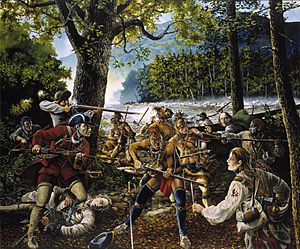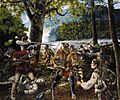Battle of the Trough facts for kids
Quick facts for kids Battle of the Trough |
|||||||
|---|---|---|---|---|---|---|---|
| Part of the French and Indian War | |||||||
|
|||||||
| Belligerents | |||||||
| Shawnee and Delaware Indian warriors | |||||||
| Commanders and leaders | |||||||
| Killbuck | Unknown | ||||||
| Strength | |||||||
| 14 or 60–70 (differing accounts) | 16 or 18 (differing accounts) | ||||||
| Casualties and losses | |||||||
| 3 dead (or many more); "several" wounded | 7 dead, 3 wounded | ||||||
The Battle of the Trough was a small but important fight during the early French and Indian War (1754–63). It happened in March or April 1756. This battle took place in a valley called the South Branch Potomac River in what is now northern Hardy County, West Virginia, USA. It was fought between Native American warriors and British-American settlers.
Contents
Why the Battle Happened
After a big defeat for the British army at the Battle of the Monongahela in July 1755, settlers living in the Allegheny Mountains were left without much protection. Shawnee and Delaware Native American groups began to raid their homes.
To help protect the settlers, two forts were built in the South Branch Valley in October. By the end of 1755, the Virginia Regiment (a group of soldiers) grew bigger. They started to staff some of these new forts. In early 1756, the new commander of the Regiment, 24-year-old Colonel George Washington, sent Captain Thomas Waggener to build two more forts. These forts were meant to protect settlers living near a rugged area known as "The Trough".
In the spring of 1756, two Native American warriors were traveling through the area. They met two white women. They killed one woman (Mrs. Brake) and captured the other (Mrs. Neff). The warriors then camped near Fort Pleasant, which was one of Waggener's new forts. That night, Mrs. Neff managed to escape and ran to the fort for safety. Some stories say the warriors let her escape on purpose to trick the settlers into coming out.
The Fight Begins
Mrs. Neff told the men at Fort Pleasant about the two warriors. But she didn't know that many more warriors were hiding nearby. Years later, a teenager who was there, James Parsons, described what happened.
The Native American warriors had split into small groups. They planned to meet up at a large spring near Fort Pleasant. Some of them showed themselves early in the morning near the fort. They fired a few shots and then marched away down the valley. This made it look like there were only a few of them.
The settlers at the fort thought they could easily chase and catch these few warriors. They sent out scouts to check for other signs of Native Americans. The scouts reported that they didn't see any other signs. So, the settlers decided to go after them.
The Battle at the Trough
That morning, 16 or 18 well-armed white men left Fort Pleasant and another nearby fort. These men were experienced fighters. They planned to attack the Native Americans. They soon got off their horses and split into two groups. They wanted to surround the warriors in "The Trough" gorge.
However, a noisy dog gave away their position. The Native Americans quickly realized they were being followed. The warriors, led by the Shawnee chief Killbuck, were actually a much larger group, possibly 60 or 70 strong.
The Native Americans were very clever. They managed to get between the settlers and their horses. This trapped the white men between a steep mountainside and the swollen river.
The battle started quickly and was very fierce. The settlers soon realized they were outnumbered and outsmarted. They had to fight their way through the Native American warriors to escape. Many settlers were killed or wounded trying to break free. Those who escaped had to run for their lives. Some jumped into the river, while others ran back the way they came.
The fight lasted for one to two hours. Seven white settlers were killed, and four were wounded. The Native Americans lost three warriors and had "several" wounded. The Native Americans also took the settlers' horses. The surviving settlers made it back to Fort Pleasant. They stayed on guard all night, ready for another attack.
After the Battle
This fight became known as the "Battle of the Trough." People in the area told stories about it for many years. One story says that British soldiers were at Fort Pleasant during the battle. Their commander, Captain Waggener, supposedly refused to help the settlers, even though they were only a mile and a half away. This made many settlers very angry.
Another difficult battle for the settlers happened soon after. It was called the Battle of Great Cacapon on April 18, 1756. These were very tough times for the settlers. They felt very unsafe and faced a lot of danger. Later, after the Native Americans had moved away, people in the area looked back on these events with more understanding.
Images for kids



